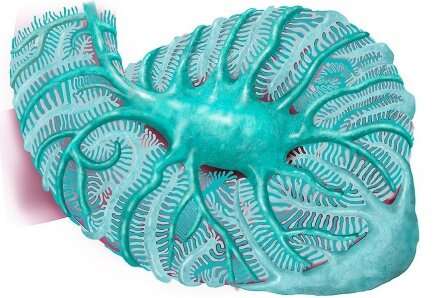
In the early stages of kidney disease, a specialized type of kidney cell called the podocyte undergoes damaging changes in both its structure and function. Those changes are key indicators of the ultimately devastating damage that end stage renal disease can cause, but these specialized cells are difficult to detect.
Now, University at Buffalo researchers have leveraged the power of digital pathology and computational modeling to develop a new approach to detecting and quantifying podocytes.
The cloud-based tool, called the PodoSighter, is described in a paper in the Journal of the American Society of Nephrology; the research is being highlighted on the cover of the journal’s November issue.
The project is an example of how advanced computational capabilities are allowing scientists to glean new information from complex images of anatomical structures.
Understanding human systems
“In the medical domain, understanding human systems depends on analyzing huge amounts of very different types of data,” said Pinaki Sarder, Ph.D., senior author on the paper and associate professor of pathology and anatomical sciences in the Jacobs School of Medicine and Biomedical Sciences. “The question is, how do we combine all these data to try and understand fundamental human systems and disease?”
Working in the emerging area of computational nephropathology, Sarder and his colleagues are focused on developing a better understanding of the information found in images of kidney biopsy samples.
“It’s been known for decades that the quantity and density of podocytes are important both for diagnosis and prognosis of end stage kidney disease,” said Darshana Govind, Ph.D., first author, who did her doctoral work in Sarder’s lab. She is now a data scientist at Janssen Pharmaceuticals.
In the early stages of kidney disease, podocytes begin to change shape and, as the disease progresses, the number of them will fall. “A healthy person has more podocytes than a sick person,” Sarder explained. “If one day we can track the loss of podocytes, then we can determine the stage of the disease.” Right now, that’s not possible, but it’s one of the goals of the UB research.
One of the biggest challenges in dealing with images of biopsied tissue is that they contain huge amounts of data. The additional challenge with podocytes is that they are found deep within the glomeruli, the sac-like bundles of capillaries that handle first-line filtration of blood in the kidneys.
“It’s very challenging to identify podocytes in an image,” Govind explained, noting there are so many cells in the glomerulus that it’s hard even for trained pathologists to figure out which nuclei belong to podocytes. Different types of staining can be used to highlight the podocytes, but sometimes the staining causes other important image information to be lost.
Convolutional neural networks
The solution they developed is to use a machine learning technique called convolutional neural networks, a learning algorithm that can distinguish specific objects in an image. It was developed based, to a certain degree, on the ways that the visual cortex in the human brain processes visual information.
The technique involves essentially “training” the computer to detect podocytes. “The tissue is prepared in the clinic and the AI-based method detects it for you,” said Govind. “You click a button and the podocytes are identified.”
Density information is also provided. “The PodoSighter not only detects podocytes, but it spits out a report on how many of these cells are identified in each glomerulus and what the density is, a key indicator for disease progression,” said Sarder. He explained that as kidney disease progresses, the glomerulus grows in size while the number of podocytes goes down.
Currently primarily a research tool, the PodoSighter can work on samples from both animals and humans. The goal is to eventually get this into routine use in clinics for human use, which the researchers say may be possible in just a few years.
The researchers conducted some of their work at the Center for Computational Research at UB.
Sarder added that there is tremendous potential for this kind of research that utilizes artificial intelligence in medicine.
“One of my goals at UB is not only to do research but also to develop a workforce, and that’s very important,” he said. “Dr. Govind has done excellent, very difficult work for her Ph.D. and has been published in a top journal.” He noted that while it’s improving, there still aren’t many women working in artificial intelligence right now.
“It’s challenging,” said Govind, “because you don’t see a lot of women in the field. I’d like to see more women join STEM and data science. It’s a great field to be in. It’s hard to be one female in a room full of men, so I encourage more women to join AI teams. There’s a lot of cutting-edge research and you’re literally changing lives, using AI applied to health care.”
Ellen Goldbaum, University at Buffalo

